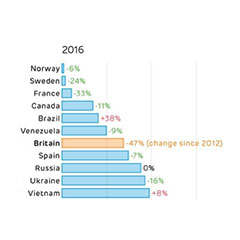Britain’s electricity is now amongst the cleanest in the world – having moved 13 places up the global rankings to be placed 7th in terms of the carbon content of its electricity among large and industrialised countries.
According to the latest Electric Insights report, produced by researchers at Imperial College London in collaboration with Drax, Britain’s shift was the biggest for any country in the league table. The most any other country moved was eight places, and this was by the Netherlands, in the opposite direction – down the leaders’ table.
The analysis shows that the UK’s carbon price has helped deliver unparalleled carbon reductions – its charge on greenhouse gas emissions has driven uptake in renewables and a shift away from coal to gas-fired power generation.
Dr Iain Staffell, from Imperial College London explained: “Since we started Electric Insights a year ago we have seen a number of ‘firsts’ across the power sector and this quarter is no different – Britain has entered the world’s top ten low carbon power league for the first time.
“Britain is reducing its carbon emissions from electricity faster than any other major country, and this has happened because the carbon price and lower gas prices have forced coal off the system – the amount of coal-fired power generation in Britain has fallen 80% between 2012 and 2016. In the Netherlands, coal-fired electricity output has risen 40% over the same period as generators only have to pay the much lower European carbon price.”
The carbon price floor is set by the UK Government. Power generators in the UK are charged £23 per tonne of carbon dioxide (CO2) produced, compared to £5 per tonne in Europe. The six countries with lower carbon electricity than Britain benefit from substantial hydropower resources or, in the case of France, a heavy reliance on nuclear.
Andy Koss, Drax Power CEO said: “The analysis by Dr Staffell and the team at Imperial College London shows quite clearly the impact Britain’s carbon price has had in terms of helping to ensure we produce cleaner power for the UK’s homes and businesses.
“It’s therefore vital that we maintain a meaningful carbon price when the Chancellor announces the Autumn Budget, if we are to meet our commitments on climate change. Without it we could see a reversal of the impressive results achieved so far – look at what’s happened elsewhere.”
Britain’s carbon emissions from electricity almost halved (47%) between 2012-16, and the carbon impact of Britain’s electricity has fallen more than twice as fast as any other major economy.
New coal power stations were built in the Netherlands between 2013 and 2016, leading to a dramatic increase in their coal consumption and carbon emissions.
Drax has upgraded half of its power station in North Yorkshire to use sustainable biomass, transforming it to become the biggest single site renewable generator in the UK and the largest decarbonisation project in Europe.
The report has been shared with HM Treasury as further evidence to support carbon pricing ahead of the Autumn Budget on 22 November 2017.
Country comparisons
Norway, Sweden and France have the cleanest power systems among large and industrialised countries due to their mountainous terrain allowing for substantial hydropower resources and a heavy reliance on nuclear in France, with 58 reactors. India and South Africa have the dirtiest power sectors on the list, with 75-90% of their power generated by coal.
Figure 1 Local carbon electricity league table – risers, fallers and non-movers between 2012-6
| Risers | Fallers | Non-movers |
| Britain up 13 places | Netherlands down eight places | Norway, Sweden and France remain at the top of the table, |
| Ukraine and Iran both moved up three places | Argentina and Egypt are both down three places | Mexico remains 14th
USA remains 16th |
| Korea and Australia are both up two places | Vietnam, UAE and Indonesia are all down two places | Malaysia remains 27th China remains 28th
Poland remains 30th |
| India remains 32nd
South Africa remains 33rd |






















